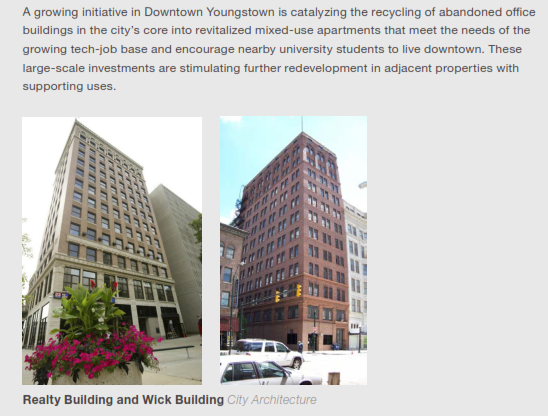On February 25, the NEOSCC Board will be voting on the the Vibrant NEO 2040 Vision, Framework and Action Products. With just under 40 days to the vote and 41 initiatives in the vision, we thought it would be good to create a countdown to the vote. Everyday over the next 5 weeks, we will be sharing an “Initiative A Day” with you so you can gent a better understanding of the vision and framework! If you would like to read all of the Initiatives, you can download them here Vibrant NEO_Recs&Init_010114.
Show your support for Vibrant NEO 2040 by adding your name to our Champions of Vibrant NEO 2040 list here!
These recommendations, initiatives, and products, are not one-size-fits all and some aspects of the initiatives won’t be applicable everywhere in the 12-county region. The Vibrant NEO 2040 Vision, Framework and Products are intended inspire and guide decision-making at the Metropolitan Planning Organization (MPO), Council of Government, and local levels to ensure that land use, transportation, and environmental considerations are simultaneously addressed by their processes. Ultimately, the implementation of Vibrant NEO 2040 is up to Northeast Ohio’s communities and residents. But regardless of the applicability of each initiative to any particular part of the region, the goal for each community within the Vision is the same: stability, prosperity, and a high quality of life for all of its residents.
Recommendation 3: Pursue the remediation, assembly, marketing, and redevelopment of abandoned properties at both the local and regional levels
Initiative 3.2: Expedite permitting and remove barriers for adaptive reuse of abandoned buildings and empty lots.
WHAT THIS MEANS. The recycling of urban land and buildings is the principal development challenge facing built-out communities. Barriers to redevelopment arise through such issues as toxic contamination, property age and code conformance, and opposition from other landowners. Communities in Ohio and elsewhere have found various strategies for reducing or removing these barriers, including internalizing certain pre-development costs like site remediation (or working with an allied entity to do so), and taking an active role in mediating between developers, landowners, and the community. One of the most effective and immediate actions that municipalities can take is exploring ways to consolidate and expedite the permitting and development review process. Los Angeles took such steps to facilitate redevelopment in the historic central business district in 2005. The dramatic success of the program led to its expansion citywide (footnote: LA citywide adaptive reuse available here: http://ladbs.org/LADBSWeb/LADBS_Forms/PlanCheck/Ord175588_zaapproval.pdf; LA adaptive reuse process overview document: http://ladbs.org/LADBSWeb/LADBS_Forms/Permits/Permitting_Guidelines.pdf).
WHY THIS IS IMPORTANT. The challenge becomes a problem when natural churn in a property market decays into long-term, structural vacancy. Invariably, municipalities are saddled with the responsibility for maintaining chronically vacant property. This saps municipalities of needed revenue, results in substandard care for a property, and dims the prospects of a productive successive use.
Over the last two decades, local governments around the country have created land banks, which are entities established to acquire and hold chronically vacant property for eventual sale to a private entity for redevelopment. While land banks are valuable policy and organization tools, they are not the full answer to addressing the challenge of widespread structural vacancy.. Policies reducing the uncertainties associated with bureaucracy and the development review process should follow, as these factors are frequently cited by developers as reasons – direct or indirect – for withdrawing from or forgoing projects in established cities or towns.
GETTING IT DONE. Local governments, particularly in the region’s legacy cities and first ring suburbs, must take responsibility for implementation of this initiative. Leadership could come from members of planning commissions or zoning boards, or administrative staff from a planning or development department. The effort could start with the following relatively easy explorations:
+ Expedited re-platting review and approval for vacant commercial and industrial properties – When building in a greenfield context, a developer can plat a property to suit his or her needs, a condition that is very difficult to replicate in an established urban context. To compensate, municipalities should consider designating areas with a high volume of vacant or abandoned commercial or industrial property for which replat applications will be fast-tracked through approval process. This can be accomplished by creating special overlay districts and adding commercial/industrial planned unit development zoning classes to municipal zoning codes; and
+ Consolidated permitting process – Municipalities interested in promoting adaptive reuse should consider forming dedicated working groups or task forces comprised of the principal divisions of government responsible for issuing permits. These working groups review adaptive reuse projects in their totality, reducing or eliminating the back-and-forth that typifies standard permitting process and enabling the developer to address multiple code issues in an efficient, coordinated fashion.
TOOL: The Youngstown Neighborhood Development Corporation developed a Vacant Land Reuse Resource Guide that contains detailed instructions for choosing a site, acquiring vacant property, preparing a site, assessing soil conditions, accessing water, and obtaining plants, fencing, and permits. The guide also outlines a number of vacant land reuse strategies, offers ideas, inspirations, and resources, and includes a project idea workbook. http://www.yndc.org/
BEST PRACTICE: A nine-month Green Jobs Training Program for at-risk youth adds deconstruction curriculum in Youngstown: Students learn the basics of building deconstruction and building material salvage. Youngstown Neighborhood Development Corporation partners with the Youngstown Metropolitan Housing Authority, Reuse Consulting, Landscapers, Mahoning County One Stop, Western Reserve Building Trade Council, churches and others. http://www.yndc.org/news-media/green-jobs-training-program-continues-deconstruction-training
PILOT: Collinwood Rising: This is a community plan for establishing a strategy for transforming vacant parcels and houses into community-based assets. Funding was awarded by an ArtPlace America grant. http://www.artplaceamerica.org/articles/collinwood-rising-7/
Lead |
Municipalities |
Target Community |
Strategic investment areas, asset risk areas |
Implementation Complexity |
Low |

